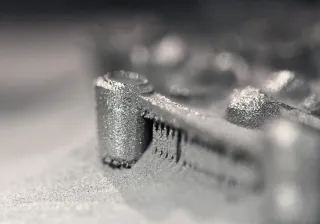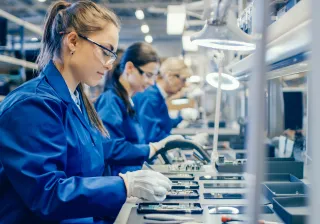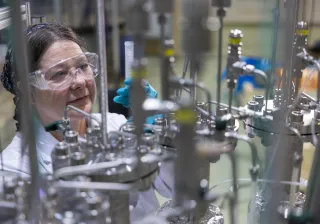Only 8.6 % of globally used materials are circulating back to be used again as raw material. At the same time, consumption is growing and increasing need of materials demand more and more primary raw materials. In order to improve materials’ circulation, research and development actions are needed for valorisation and utilization of the current losses generated, i.e. side-streams and waste materials. Additionally, we need new approaches, extensive efforts and co-operation between different actors and cross-sectorally. As a recent example, we worked in research project funded by Academy of Finland with multi-disciplinary research consortium, and investigated the utilization of mine tailings as raw materials for ceramic industry [1].
Material consumption was in 2017 over triple compared to 1970, and still 91.4 % of globally used materials are not circulating [2].There are considerable losses and waste generation during production and manufacturing, even before the materials are used for the first time. The share of mine tailing from all the processed rock and ore was 71% in Finnish mines (2017). The total amount of waste from mining and quarrying was around 96 million tonnes (in year 2018), and mineral waste accounted for around 90 per cent of the total amount of waste generated in Finland [3]. For this reason, the design out waste and valorisation of mineral waste streams is increasingly relevant gaining significant economic and environmental benefits.
In 2015, we started to investigate the utilization of mine tailings as secondary raw materials in four year CeraTAIL (Novel synthesis methods for advanced porous ceramics from mine tailings) project funded by Academy of Finland. Our target was not stabilizing and low value utilization, it was more ambitious; to develop high value products with special functions, such as materials for high temperature solutions.
Added value products from side streams and even better performance than virgin materials
We developed ceramic materials from mine tailings in the project, and compared the developed materials properties to materials produced from virgin raw materials. Our novel finding (found in published scientific literature [4] [5] [6] [7] [8]) revealed that waste based ceramic materials can have even better properties than virgin raw material based ceramics. We specially concentrated on material compositions that can withstand high temperatures and can be used as thermal and electrical insulation applications. As a research method, we utilise thermodynamic calculations for finding potential side stream combinations to tailor mine tailing chemistry.
We found that certain mine tailings are excellent raw materials for aluminium-silicate based ceramics, showing capability for high temperature solutions. Another research result was that we can produce ceramic coatings from mine tailings having comparable level electric insulation properties than reference materials produced from virgin raw materials. Wear performance and therefore expected lifetime of the secondary raw material based coating was even better than reference coating produced from virgin materials.
Research investments are needed for the sustainable future
CeraTAIL project resulted several scientific findings that can be utilized in Finland and globally. We could decrease mining environmental burden by utilizing residues as raw materials and substitute same amount currently used virgin raw materials by secondary raw materials. From business perspective, we could get low price waste raw materials with lower carbon footprint compared to virgin materials. We will continue design out waste, after CeraTAIL project, and are looking for funding and co-operation partners for this topic. We will hear more about the topic in near future, Marjaana Karhu is finishing her doctoral thesis during this autumn.
For more information, please contact us about design out mine tailings.
Lähteet:
- [1]Solismaa, S., Ismailov, A., Karhu, M., Sreenivasan, H., Lehtonen, M., Kinnunen, P., Illikainen, M., & Räisänen, M. L. (2018). Valorization of finnish mining tailings for use in the ceramics industry. Bulletin of the Geological Society of Finland, 90(1), 33–54. https://doi.org/10.17741/bgsf/90.1.002
- [2] https://www.circularity-gap.world/2020
- [3] http://www.stat.fi/tietotrendit/artikkelit/2019/kaivosten-kokonaisnostosta-valtaosa-paatyy-jatteeksi/
- [4] http://www.stat.fi/til/jate/2018/jate_2018_2020-06-17_tie_001_en.html
- [5] Karhu, Marjaana; Lagerbom, Juha; Kivikytö-Reponen, Päivi; Ismailov, Arnold; Levänen, Erkki. Reaction Heat Utilization in Aluminosilicate-Based Ceramics Synthesis and Sintering. Journal of Ceramic Science and Technology 08 (01) (2017) 101-112.
- [6] Karhu, Marjaana; Lagerbom, Juha; Solismaa, Soili; Honkanen, Mari; Ismailov, Arnold; Räisänen, Marja-Liisa; Huttunen-Saarivirta, Elina; Levänen, Erkki; Kivikytö-Reponen, Päivi. Mining tailings as raw materials for reaction-sintered aluminosilicate ceramics: Effect of mineralogical composition on microstructure and properties. Ceramics International 45 (2019) 4840–4848.
- [7] Karhu, Marjaana; Lagerbom, Juha; Solismaa, Soili; Huttunen-Saarivirta, Elina. Magnesite-rich mining tailings as a raw material for refractory ceramics – microstructural and thermal analysis. Proceedings of the Estonian Academy of Sciences 68 (2) (2019) 145–149.
- [8] Karhu, Marjaana; Lagerbom, Juha; Honkanen, Mari; Huttunen-Saarivirta, Elina; Kiilakoski, Jarkko; Vuoristo, Petri; Solismaa, Soili; Kivikytö-Reponen, Päivi. Mining tailings as a raw material for glass-bonded thermally sprayed ceramic coatings: microstructure and properties. Journal of the European Ceramic Society (2020), DOI: 10.1016/j.jeurceramsoc.2020.04.038






